Minefield for China coal workers
Country’s bright future clouded by deadly industry powering its growth.

 |
| Officially, China has 600,000 sufferers of the lung disease which plagues miners |
Two things dominate the skyline above Fuxin in northeastern China: the giant cooling towers of the power station in the middle of town and in the distance, a man-made pyramid called Gan, an enormous pile of slag, residue from the hunt for coal.
Keep reading
list of 4 itemsCould shipping containers be the answer to Ghana’s housing crisis?
Thousands protest against over-tourism in Spain’s Canary Islands
Holding Up the Sky: Saving the Indigenous Yanomami tribe in Brazil’s Amazon
If Greenpeace activists could see the Fuxin power station their blood would boil.
At any one time three of the five cooling towers spew incalculable amounts of carbon dioxide into the air. They would, for sure, protest.
Deadly explosion
But one wonders what they would say about Gan and the mines of the Fuxin mining company.
| In video |
More than 300m tall, Gan stands like a giant tombstone over the mining community below.
It may not be damaging to the environment but it is devastating to the miners.
Two years ago its colliery at Sunjiawan became notorious when 214 miners were killed in a gas explosion deep underground on February 14, the country’s worst mining accident in 65 years.
In a country that hardly blinks an eye when a miner is killed, it caused an outcry.
Ding Gui Fen’s son was killed in that blast, buried 250m down, in an underground area known for the build-up of methane gas.
“I became a widow when I was 35 and I only had this son. I miss my son very much. Day and night I miss him. In my dreams I think of him,” she told me.
At 68; her face has been chiselled by many winters in the cold north.
“The communist party looked after us,” she added. “I would like to thank them.”
However tragic, this accident was blessed because it was big.
It spurred the Chinese government to do something, putting pressure on the mine owners to pay $30,000 compensation for each dead miner.
Normally miners sign their lives away for as little as $3000. Salaries are low. There are few, if any benefits.
’30 per cent risk’
Miners, and indeed the country, seem to be so accepting of their plight.
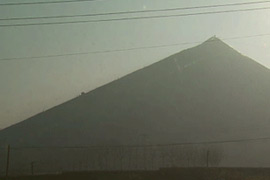 |
| Miners toil in the shadow of Gan, a man-made pyramid of slag, residue from the hunt for coal |
Ling is a miner at Sunjiawan colliery and benefits from the intervention of the government. He is now worth more dead than alive. Alive he gets a salary of $250 a month.
“Are you scared when you go to the coal face?” I ask him.
He laughs, almost disdain for a foreigner in nice clothes who could not possibly have any idea what it was like to dig coal 400m below ground.
“You get used to it,” he responds.
“You don’t think about it. If you think about it you couldn’t do your job. No, I am not scared.
“It is still dangerous; it is very risky. There is a saying in China that whenever the miner goes below ground there is a 30 per cent risk.”
He has been a miner for 20 years, since he was 18.
On that black day in 2005 he was not down at the face because he was recovering from a broken leg caused by another pit accident.
He says he has seen many accidents, many injuries and many deaths in his time underground. It just seems to be a miner’s occupational hazard.
No protection
According to official figures over the last five years around 35,000 miners have died in accidents throughout China. Unofficially it could be as many as four or five times that figure.
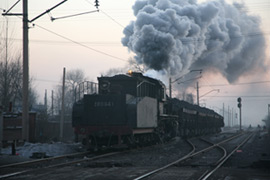 |
| China’s booming economy is largely powered by coal [Photo by Tony Birtley] |
Near Fuxin, standing on a hill above a small private mine, I saw a scene which could easily have come from another century.
Men were enveloped in huge black palls of smoke as they shovelled coal newly brought from the coalface.
At first you had to strain to see there were men there, such was the volume of coal dust which engulfed them.
No masks. You could only imagine what damage to their health this was causing.
Officially there are 600,000 sufferers of pneumoconiosis, the lung disease which plagues miners.
There are said to be 70,000 new cases every year. Many of these men will die. No records are kept to say how many have already died.
It is hard to tell how many men die in mining accidents because there are thousands of privately owned mines in China which cut corners for profit.
Safety measures are ignored, miners are exploited, pit inspectors are often bribed and toll figures are either not revealed or massaged to make them “acceptable”.
‘Sacrifice’
What seems to be acceptable in china is the “sacrifice” of miners in pursuit of power and profit.
China needs power to maintain its economic growth, currently at an enviable high of 11 per cent a year. And coal is the way ahead.
There are plans to build another 500 coal-fired power stations in the next 10 years.
And with estimated coal reserves of around 115 billion metric tonnes, what happens below ground is essential to what happens above.
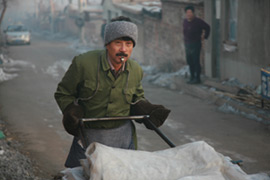 |
| Mining for coal is like going to war, Xiao Shun says [Photo by Tony Birtley] |
A whistle pierces the chill of the air, made by a disabled man wheeling his cart up the mist-shrouded streets of Sunjiawan.
His name is Xiao Shun, he is 53-years-old and he sells tofu to the mining community.
Once he was a miner until he broke both legs and an arm in a pit cave-in. No big compensation for him, only a small pension and the memories of the dangers in the bowels of the earth.
“When we go to the coalface, it is like soldiers going to the battlefront,” he explains.
“No one knows who is going to die and who is going to come back. That is why miners eat and drink their salaries because they don’t know if they’ll be here tomorrow.”
Uncertainty
Tomorrow, for the mining communities of Sunjiawan and Fuxin, is an uncertain thing.
The coal reserves in Laoning province where the two communities are located are running out.
Looking over the houses only one in three chimneys belch smoke.
Many of the houses are empty, front doors padlocked, windows boarded up, a testimony to the number of people who have gone elsewhere in search of work.
In Laoning there are about 170,000 unemployed miners.
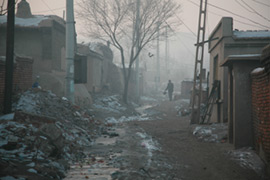 |
| Miners get little of the profits raked in by mine owners [Photo by Tony Birtley] |
You can see many standing on street corners of Fuxin, shovel in hand, offering their services for daily manual work.
The profits raked in by the mine owners are not reflected in the lifestyle of the miners.
Looking at the rows of single-storey houses around the Sunjiawan pit is like taking a peak back in time. Most families live in two rooms, a basic kitchen and a bedroom-cum-sitting room. No indoor toilet. No running water.
On a cold December day the temperature was nudging -10 degrees Centigrade. At least coal is cheap to keep them warm.
In Fuxin a statue of Mao Zedong stands in the centre of a large traffic island.
It is one of only a few left in the country.
He stands with his arm raised facing Fuxin power station, the cooling towers emitting huge palls of smoke.
They say miners’ conditions have improved since his days.
It is hard to imagine what they were like before.
They say China’s future is bright. But there is still a shadow hanging over the future of Chinese miners and their odds for survival.
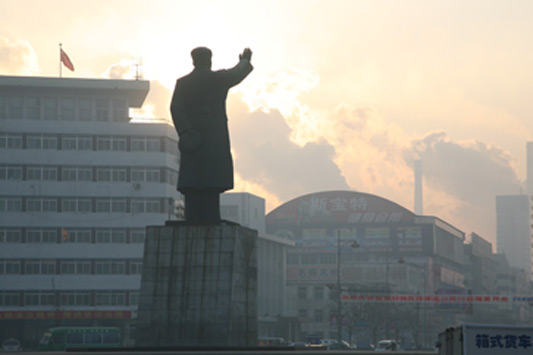 |
| If miners’ conditions have improved since Mao’s time, it is hard to imagine what they were like then [Photo by Tony Birtley] |
